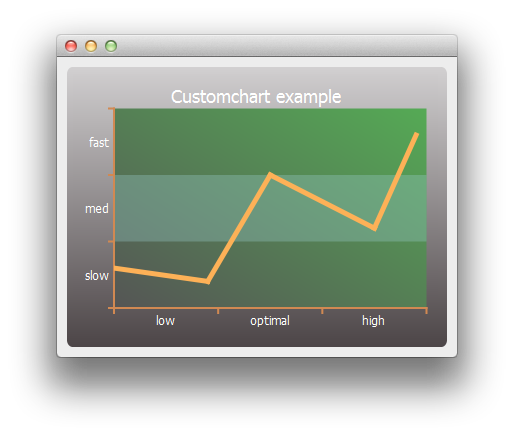Warning
This section contains snippets that were automatically translated from C++ to Python and may contain errors.
Customizing Charts#
Shows how to customize the appearance of chart elements.
Note
This is part of the Charts with Widgets Gallery example.

We begin by creating a simple line series and a chart object.
series = QLineSeries() series << QPointF(0, 6) << QPointF(9, 4) << QPointF(15, 20) << QPointF(25, 12) << QPointF(29, 26) chart = QChart() chart.legend().hide() chart.addSeries(series)
First we customize the series and the chart’s title and background.
# Customize series pen = QPen(QRgb(0xfdb157)) pen.setWidth(5) series.setPen(pen) # Customize chart title font = QFont() font.setPixelSize(18) chart.setTitleFont(font) chart.setTitleBrush(QBrush(Qt.white)) chart.setTitle("Custom Chart") # Customize chart background backgroundGradient = QLinearGradient() backgroundGradient.setStart(QPointF(0, 0)) backgroundGradient.setFinalStop(QPointF(0, 1)) backgroundGradient.setColorAt(0.0, QRgb(0xd2d0d1)) backgroundGradient.setColorAt(1.0, QRgb(0x4c4547)) backgroundGradient.setCoordinateMode(QGradient.ObjectBoundingMode) chart.setBackgroundBrush(backgroundGradient) # Customize plot area background plotAreaGradient = QLinearGradient() plotAreaGradient.setStart(QPointF(0, 1)) plotAreaGradient.setFinalStop(QPointF(1, 0)) plotAreaGradient.setColorAt(0.0, QRgb(0x555555)) plotAreaGradient.setColorAt(1.0, QRgb(0x55aa55)) plotAreaGradient.setCoordinateMode(QGradient.ObjectBoundingMode) chart.setPlotAreaBackgroundBrush(plotAreaGradient) chart.setPlotAreaBackgroundVisible(True)
Then we customize the axes.
axisX = QCategoryAxis() axisY = QCategoryAxis() # Customize axis label font labelsFont = QFont() labelsFont.setPixelSize(12) axisX.setLabelsFont(labelsFont) axisY.setLabelsFont(labelsFont) # Customize axis colors axisPen = QPen(QRgb(0xd18952)) axisPen.setWidth(2) axisX.setLinePen(axisPen) axisY.setLinePen(axisPen) # Customize axis label colors axisBrush = QBrush(Qt.white) axisX.setLabelsBrush(axisBrush) axisY.setLabelsBrush(axisBrush) # Customize grid lines and shades axisX.setGridLineVisible(False) axisY.setGridLineVisible(False) axisY.setShadesPen(Qt.NoPen) axisY.setShadesBrush(QBrush(QColor(0x99, 0xcc, 0xcc, 0x55))) axisY.setShadesVisible(True)
Then the axis label values and ranges. Once the axes are ready, we set them to be used by the chart.
axisX.append("low", 10) axisX.append("optimal", 20) axisX.append("high", 30) axisX.setRange(0, 30) axisY.append("slow", 10) axisY.append("med", 20) axisY.append("fast", 30) axisY.setRange(0, 30) chart.addAxis(axisX, Qt.AlignBottom) chart.addAxis(axisY, Qt.AlignLeft) series.attachAxis(axisX) series.attachAxis(axisY)
Finally, we create a view containing the chart.
createDefaultChartView(chart)
Now we are ready to show the chart on a main window.